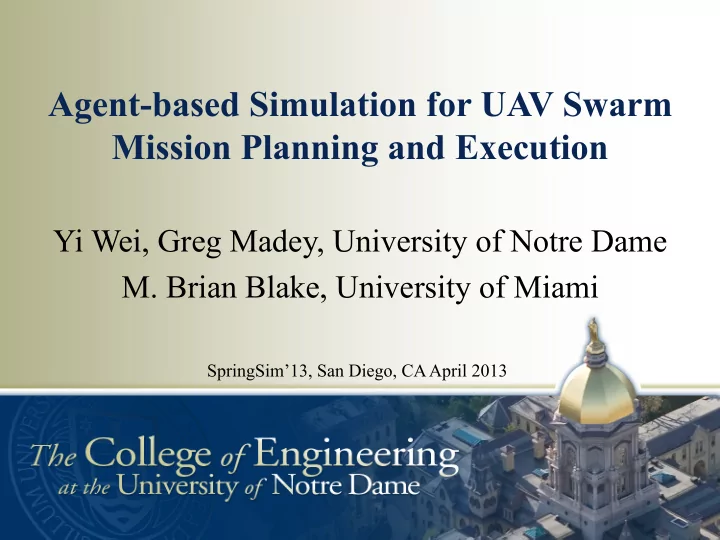

Agent-based Simulation for UAV Swarm Mission Planning and Execution Yi Wei, Greg Madey, University of Notre Dame M. Brian Blake, University of Miami SpringSim’13, San Diego, CA April 2013
Outline • Introduction and Motivations • Problem Definition • Technical Approaches and Evaluations • Conclusion and Future Work 2
Introduction: Unmanned Airborne Vehicles • A UAV is an aircraft that do not require on- board pilots. • Usually controlled remotely or by an autonomous computer. • Cheaper than their piloted counterparts, but also with limited capabilities. 3
Applications of UAVs journalism hunting 4 highway monitoring real estate sale
From single UAV to a swarm • Prices decrease while capabilities increase • UAV swarms for future airborne operations • Current control approaches have limited scalability • New models and approaches required to fly the swarm, not individual UAVs 5
The Problem Schedule missions onto a swarm of UAVs, monitor their execution, and make necessary adjustments. 6
Mission Planning Example Mission Swarm T1 V2 V4 T3 V1 V3 T2
Definitions • UAV: basic unit • Swarm: a set of UAVs • Task: simple, specific objective • Mission: set of interdependent tasks 8
Agent-based Approach • A single Swarm Control Agent (SCA) for mission planning • Multiple UAV Agents (UAs) for mission scheduling • Agents communicate through messages 9
Global-Local Hybrid Planning • SCA assigns tasks to different UAs based on its global knowledge and other constraints • Each UA schedules new tasks based on local state • UAs periodically update the SCA about their status 10
Message Types 1. New mission 2. New task 3. Status request/return 4. Task completion 5. Task reassignment 11
Different Scheduling Policies • First Come First Serve • Insertion • Traveling Salesman • Adaptive 12
Simulation Program • Implemented as a Java multi-thread application • The SCA and all UAs are represented as threads • Missions and the swarm are visualized during execution 13
14
Simulation Result 1 Relative Performance 0.8 0.6 0.4 0.2 0 0 100 200 300 400 500 Task Arrival Rate (steps/task) Insertion TSP Adaptive 15
Simulation Result 0.3 Relative Performance 0.25 0.2 0.15 0.1 0.05 50 100 150 200 250 300 350 400 450 500 Number of Tasks Insertion TSP Adaptive 16
Conclusion • The adoption of swarm based UAV operations require new control models and algorithms • An agent-based approach for swarm mission planning is introduced • Global-local hybrid approach is employed to facilitate planning process 17
Future Work 1. Incorporate more realistic scenarios, such as UAV losing contact to the ground station 2. Incorporate more task types and task dependency types 3. Development of an expressive mission specification language 18
Thank You! Questions ? 19
Recommend
More recommend